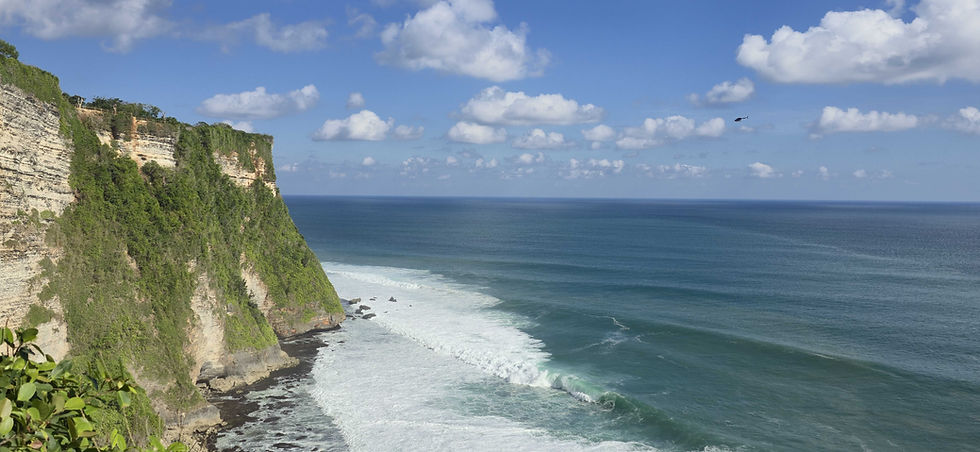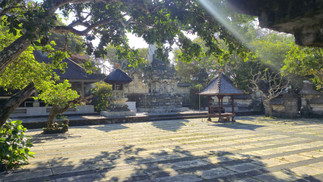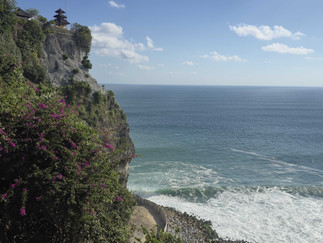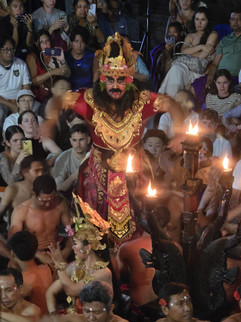Uluwatu Temple
- Shannon
- Sep 1
- 4 min read
Updated: Sep 16
Between the Waves and the Gods
Overlooking the vast and turbulent Indian Ocean on Bali’s Bukit Peninsula, Uluwatu Temple (or Pura Luhur Uluwatu) perches 70 metres above the waves, a landmark of both awe and solemnity. Archaeological evidence shows its origins date back to the 9th century, based on an ancient split gateway bearing a chronogram marking 886 AD, confirming its megalithic roots as one of the island’s oldest sacred sites. For centuries, locals have believed the temple safeguards Bali from malevolent sea spirits, transforming the cliff top sanctuary into a liminal space where human fragility meets unseen forces. The roar of the ocean below and the sheer precipice serve as constant reminders of mortality, nature’s raw power and the enduring authority of the divine.

Uluwatu is deeply tied to Balinese Hindu cosmology. Hindus believe that all three divine powers, Brahma, Vishnu and Siva, merge here and the temple is especially dedicated to Siva Rudra, a deity representing all elements and aspects of life in the universe. As one of the six Sad Kahyangan, the holiest temples on the island, Uluwatu is central to maintaining Bali’s spiritual balance. The rituals performed here are not ceremonial theater, they are considered essential acts to harmonise the forces that shape life, death and the unseen currents of the cosmos.
In the 11th century, the Javanese priest Empu Kuturan formally established Uluwatu as a centre of Hindu ritual and spiritual authority. Recognising the cliff as a site of extraordinary energy, he designed the temple so offerings could commune with both protective and vengeful spirits. Its exposed, isolated position was deliberate, a natural fortress overlooking the huge ocean, where mortals are humbled by the immensity of nature and the weight of divine power. Even the wind that sweeps across the cliffs carries a low, mournful echo of centuries of devotion, a subtle reminder of the unseen forces that dwell here.

The temple’s long tailed macaques are not mere nuisances but are entwined with its sacred mythology. According to legend, the monkeys serve as guardians of the temple, punishing disrespect and preserving sacred relics. Their sudden screeches, daring raids on personal belongings and shadowy movements across the terraces remind visitors that Uluwatu is a domain where human arrogance is tested. The monkeys are living symbols of the temple’s power, unpredictable yet indispensable to the spiritual ecosystem.
The cliffs and hidden terraces of Uluwatu heighten its sense of otherworldliness. Each evening, the Kecak dance unfolds on the cliffside, enacting the Ramayana’s battle of gods and demons mere steps from a lethal drop. One false move could be the last, a stark reminder that here, beauty and danger are inseparable. In the crevices and caves, offerings of flowers, incense and rice are left for spirits whose presence is unseen yet undeniably potent. The air is heavy with salt, smoke and stone, a tangible tension that mirrors the fragile boundary between mortal life and the divine forces that watch over it.

Even as Bali modernises, Uluwatu retains an aura of authority. Its split gates, adorned with grotesque figures and demonic faces, do not merely impress, they warn. The temple is a place of vigilance, where human life is fleeting, mortality is palpable and the spiritual currents of the island press close. Between the cliffs, the monkeys and the devotion of many generations, Uluwatu stands as a stark, enduring reminder. Bali’s sacred forces are neither gentle nor forgiving and even paradise carries shadows.

🗺️ Location
Jalan Uluwatu, Pecatu Village, Badung Regency, South Kuta, Bali, Indonesia
🚆 How to get there
Uluwatu Temple, located on Bali’s south coast just south of Jimbaran and about 35 minutes from Ngurah Rai International Airport, is roughly 25 km's south of Kuta, typically taking around an hour to reach. However, travel times can be significantly longer due to Bali’s notorious and often unpredictable traffic. As there is no public transport to the temple, the most convenient way to get there is by hiring a private driver, who can navigate the congested coastal roads, ensure a more comfortable journey and get you back to your hotel when you're finished. This will set you back around 40,000 - 60,000 IDR for a 4 - 6 hour return trip.
⭐ Attraction Info
Uluwatu Temple is open to visitors between 7am - 7pm daily but as an active place of worship it remains accessible 24 hours a day for prayer. Entry for international visitors is 50,000 IDR for adults and 30,000 IDR for children and all visitors are required to wear a sarong and sash, which are provided at the entrance for free. The temple is notorious for its cheeky macaques. Though their faces appear sweet, these mischievous monkeys are skilled at stealing tourists’ belongings, from hats to cash and will only return them for food. They are among the most aggressive monkeys on the island, so it is wise to keep valuables secure and avoid carrying visible snacks. If they can’t see anything worth taking, they usually leave visitors alone. The nightly Kecak dance at Uluwatu Temple is performed twice, usually at 6pm and 7pm, on a cliffside stage with the ocean as a dramatic backdrop. Tickets for each performance are sold separately, costing 150,000 IDR for adults and 75,000 IDR for children.
Thanks for reading about the Uluwatu Temple. Check out more awesome destinations here!








































